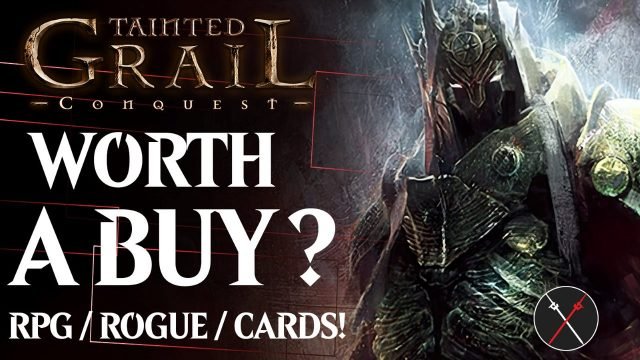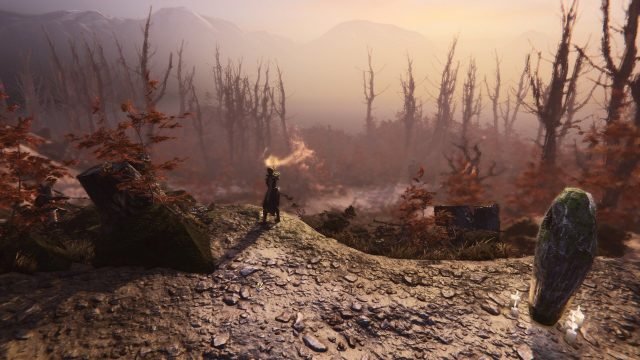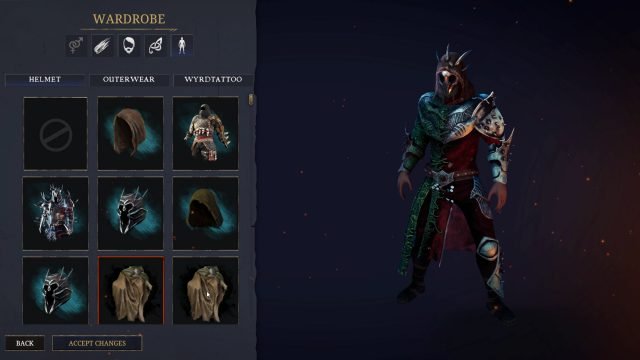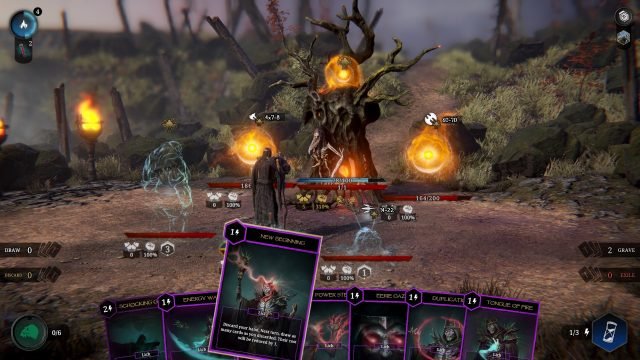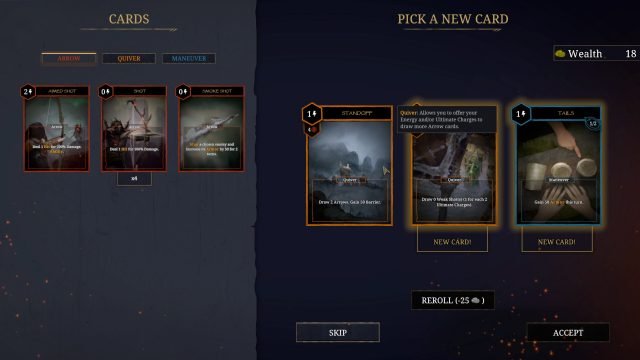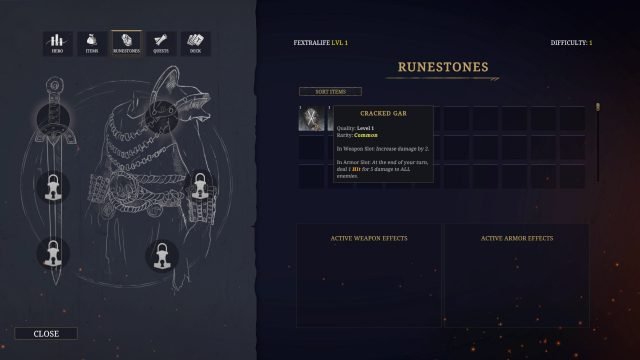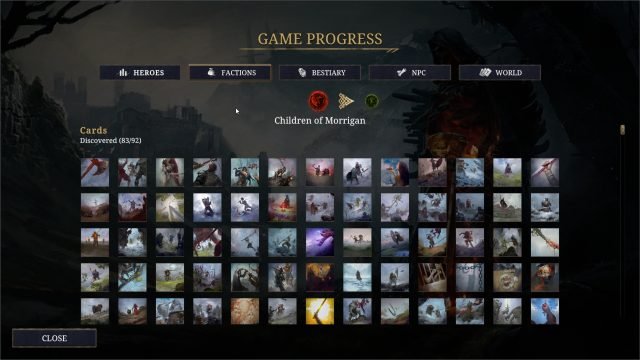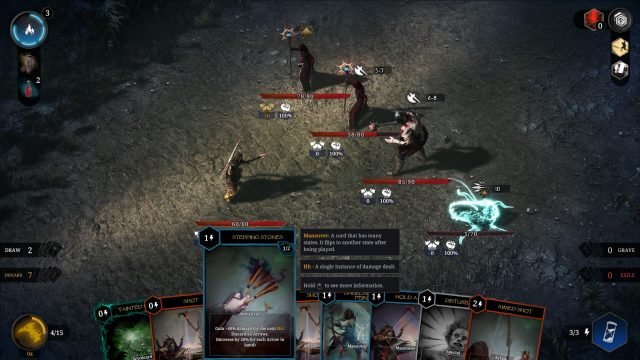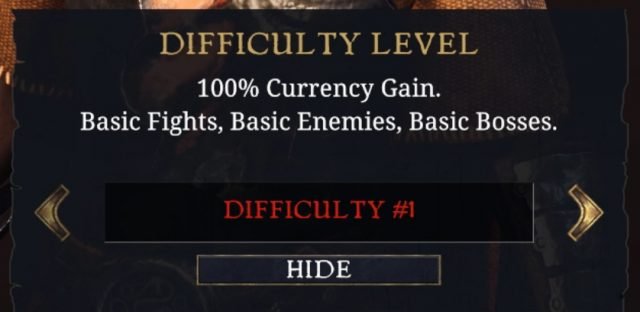In this Tainted Grail: Conquest How to get started article we will be talking about the new Rogue-Like Card game developed and published by Awaken Realms Digital. The game fully releases for PC on May 27 and will be available for all users on Steam.
This is a sponsored post. Please note sponsored posts are only sponsoring coverage, our opinions on the game are our own and not affected by any business relationships with developers or publishers.
Tainted Grail: Conquest Preview & Features Overview
Name: Tainted Grail: Conquest
Platforms: Steam
Developer: Awaken Realms Digital
Publisher: Awaken Realms Digital
Release Date: 27 May 2024
Genre: Rogue-Like, Card Game, RPG
What is Tainted Grail Conquest?
Tainted Grail: Conquest mixes together complex deck-building, as well as Rogue-Like and RPG Elements. You explore a procedurally generated world from a third-person perspective, interact with Events and NPCs, and fight enemies with card-based combat featuring 3D battle arenas and animations. This is further bolstered by the 9 different Classes Tainted Grail has, each with their own unique Cards, Passive Skills and Ultimate Abilities.
General Overview & Setting
The game takes place on an island called Avalon themed after a dark Arthurian World. The island was consumed by a mysterious fog called “The Wyrdness” that bends reality and time while deforming everything it touches.
The main objective of Tainted Grail is to uncover the truth of what is happening on Avalon, as well as meeting and saving the various NPCs that you find during your attempts to do so. Many of these NPCs can be invited to your village, where they will provide various merchant services that will become permanently available for all your runs.
Tainted Grail has a really dark atmosphere that is brought to life in no small part by Narration, Voice Acting and Artistic images displayed during the various dialogues. The level of immersion that the developers achieved by combining these elements is simply outstanding, and one of the aspects that I enjoyed most about my time with the game.
Character Creation and Game Flow
When you first start Tainted Grail you’ll need to create your character. You can customize your character’s Gender, Skin Color, Hair Style, Facial Hairstyle and Hair Color, and a Tattoo. Each time you start a new run you’ll have the option to modify your character’s appearance with the exception of Gender which is locked after Character Creation.
As you progress through the game you’ll also unlock Gear that you can use to customize your character’s appearance. These include Helmets, your Armor, and a special type of Tattoo. All of these Cosmetic upgrades are unlocked through game progression. Tainted Grail has no microtransactions and everything you unlock is tied to your progress, motivating you to play more and more runs.
Starting a Run
You’ll start your run at your own Village. The main goal of the game is to rebuild your Village by rescuing NPCs that are lost through the Wyrdness. During your runs you can collect resources to unlock permanent Village upgrades that will carry over to new runs.
There are many doors to leave the Village, each of them leading to a different tier area. You’ll start on a Tier 1 area where you’ll need to look for the boss and defeat it. Once you do, the Tier 2 area door will open and so on, you get the idea.
As soon as you leave the Village you’ll notice that your vision is blurred due to the Wyrdness. There are 6 Wyrdness levels, and each of them will affect your vision, fights and quests in different ways. You’ll need to use Wyrdcandles (which are located on the bottom left part of the screen) to disperse the Wyrdness and increase the Wyrdness level. Each Wyrdcandle you consume will provide you with 3 levels, but the Wyrdness Level bar will fall as you walk across the map meaning you’ll need to carefully manage it.
The main importance of Wyrdness level is how it affects combat, as you might randomly get Bonuses or Penalty cards called “Wyrdcards”. These Wyrdcards can have a huge positive or negative impact in your fight, so make sure to read them carefully and try to remain with the highest Wyrdness level as possible. This might remind players a bit of Darkest Dungeon.
Combat
Combat is divided into turns. Turns will always start with your own actions, and then the enemy actions will follow. Tainted Grail Conquest is a very complex game and you want to make sure that you understand all the information that is being displayed on the screen.
- On the lower middle part of the screen you’ll find your cards. Each card displays its Energy cost on the top left corner and its type and effects in the middle. Cards also have different colors to quickly differentiate their type.
- On the bottom right corner of your screen you’ll find your current and max energy. Energy is used to play cards and will be refilled at the start of each turn. Leftover energy will not carry over to the next turn.
- On the bottom left part of the screen you can find your current and max ultimate charges. You can mouse over it to learn more about it.
- On the top left part of the screen you’ll see the current Wyrdness Level, as well as your Wrydcandles and consumable items. Consumable items don’t require energy so they are a great way to get the upper hand in any combat. They are expensive and hard to come-by so its important to learn when and how to use them.
- On the top right corner of the screen you can see your currently equipped Runes and their effects.
- On each side of the screen you’ll find your deck stats. Draw is the amount of cards left in your deck. Discard are the cards that you discarded this turn. Grave are the cards that you used this turn, and Exile contains cards that can only be used once.
- Finally, on the center of the screen you’ll see your own character as well as the enemies.
The middle bar displays the character’s health. The armor Icon indicates the current armor level, which reduces a percentage of the incoming damage. The fist indicates the current damage output. Any additional status effect will be displayed next to the fist, and you can mouse over it to learn more information.
Enemies also display a symbol on top of their heads. This indicates what they intend to do on the current turn. You can mouse over these icons to learn exactly what they do. If numbers are shown, this indicates that the enemy will attack for the given values. A number followed by an X (2x for example) will mean that the enemy will perform X amount of attacks for the damage displayed. You can also learn a lot about the enemies by mousing over them, as this will display their role. Make sure to always mouse over new enemies so you can get a general idea of what they do.
Leveling Up & Player Level
Defeating enemies and winning combats will earn you experience to level up your character to a maximum level of 20. Every Level you’ll be able to choose one out of three cards to add to your deck. Every 2nd Level you’ll be able to choose one out of three passive Class skills. Every 10th Level you’ll be able to choose one out of three rune reforges, which improves your ultimate ability.
Runestones & Slots
As soon as you meet the Blacksmith NPC during your playthrough, you’ll be able to find Runestones as loot from enemies or buy them from stores. Runestones are the only kind of equipable item and their effect will depend on the Rune Type, its rarity and the slot where you placed it. Three runes of the same type can be combined into a higher rarity rune of the same type.
You start off with 1 Weapon Slot, 1 Armor Slot and 4 Consumable Slots. The Weapon and Armor Slots can be filled with runes, and the consumable slots will determine the consumables that you can use during combat. You can unlock further slots by completing various quests during your runs.
World, Quests, NPCs and Locations
The world is procedurally generated, so each run the layout will change. Navigation can be a bit tricky at times, but you can check the minimap on the top right part of the screen to know exactly where you can or can’t go.
Milestones are a special type of location that you’ll find through out the map. You can activate them to dissipate the Wyrdness across a large area around them, or dismantle them to acquire Wyrdcandles or Buffs.
You’ll meet all sorts of NPCs during your runs, and most of them provide you with Dialogue options that may impact what they do. Some NPCs also give you quests that might require that you find them on multiple runs to complete them.
Some other NPCs or Locations act as more scripted events where you can anticipate the outcome they will provide such as a heal, trade or a special reward.
All of these are classic Rogue-Like elements that fit well within the game and motivate you to explore the whole area to make sure you are not missing an important event or reward.
Finishing a Run & Rewards
Once you finish a run (either by winning or dying), you’ll gain experience points based on your score. With enough Experience Points you’ll be able to level up your save file, unlocking new content such as more cards from your Faction Pool, Cosmetic Gear, Class Passives and more.
It’s a clever feature because it limits the amount of things that you can do at the beginning of the game, while increasing your options as you put more and more hours in, providing a steady but noticeable progression as you discover more cards and passives that get thrown into the mix. This also provides you with motivation to finish a run with the highest score possible to unlock new things to try out.
Factions and Classes
Tainted Grail features 3 different Factions, each with 3 different Classes for a total of 9. Each faction has a unique pool of cards that’s shared among its Classes, and each Class has a different starting deck, Ability Card, Ultimate Ability, Passive Ability and Passive bonuses. The Ultimate ability can be used once per round, provided that you have enough Ultimate Charges, and each Class has its own way of gaining Ultimate Charges. Note that you will have to unlock Classes as you work your way through the game.
I personally recommend that you start off by using the Children of Morrigan Faction until you get used to the game mechanics, and once you are confident enough, move on to the others. I enjoyed the starting class (Wyrdhunter) the most, allowing me to play very offensively, dealing massive amounts of damage with the ultimate. There’s nothing more enjoyable than to one-shot that annoying creature that you’ve been avoiding for 10 turns.
Children of Morrigan Faction
The Children of Morrigan represent Melee Fighters. Their Cards focus on blocking enemy attacks, reducing enemy armor and dealing high amounts of damage. Their classes are: Wyrdhunter, Pathfinder and Berserker.
Wyrdhunter
- Passive Ability: Places 1 Combo Mark each time you hit an enemy. When 4 Combo Marks are reached the enemy becomes vulnerable and takes +75% incoming damage.
- Ability Card: Allows you to increase the next hit damage by 100%.
- Ultimate: Deals a massive amount of damage to a single target depending on the amount of charges it has. You get 1 ultimate charge each time you hit an opponent.
The Wyrdhunter is an offensive class that focuses on doing multi-hit attacks to gain ultimate charges and apply the vulnerable state on enemies. Then, they can use their Ability Card to double their damage and use their ultimate ability to deliver a massive blow on a single enemy.
Pathfinder
- Passive Ability: Gain a Focus charge (+50% damage) or every consecutive turn without taking any damage. Any hit will reset this streak back to 0.
- Ability Card: Duplicate the next stance card played
- Ultimate: Draw 1 card for every 3 charges consumed, gain 1 energy for every 6 charges consumed. You gain 1 ultimate charge for every stance you use
The Pathfinder is a defensive class that focuses on avoiding enemy damage while they slowly grow in power by gaining Focus Charges. Their Ability Card allows them to gain more Blocks or Barriers each turn increasing their survivability. The Ultimate ability can be used to gain more energy and cards if you are in a situation where you cannot avoid damage and require more cards.
Berserker
- Passive Ability: When below 50%HP gain +1 Energy
- Ability Card: Gain 25 Armor and retaliate 5 damage per Hit Until the End of Turn
- Ultimate: Gain lifesteal ability until end of Turn. You get 1 ultimate charge each time you are hit
The Berserker mixes defense with offense by increasing your combat capabilities as you drop on health. Your ability card will allow you to receive more hits for less damage and the extra energy points allow you to play more cards each turn. Once your health drops low enough you can spend your ultimate charges to gain Lifesteal and repeat the process
Moonring Faction
The Moonring Faction represent the invokers of the game. Its Classes are Blood Mage, Summoner and Necromancer. Their cards focus around summoning creatures to attack, block buff or debuf. There are 4 different summons that are shared between its 3 different classes with small variations:
- Abomination: This creature deals medium AoE damage but has low health
- Fae: They grant passive improvements for the player or the other summons
- Wyrm: This creature can make multiple attacks on a single turn, reducing the enemy armor with each attack
- Golem: Golems will redirect all hits to them, providing safety to your own character as well as your other summons. It can also heal itself.
During Character Creation you’ll select one creature between Abomination, Wyrm and Golem and you’ll start each fight with that summoned creature.
Summons can be Activated and also Promoted, but each class handle these aspects on a different way.
Blood Mage
- Passive Ability: All Summoned Creatures auto-activate in their respective turns. At the start of every turn, every summon gets promoted. If they exceed level 4 they Overcharge, triggering a summon-specific special effect and perish
- Ability Card: Offer 5HP. Draw a random summon from your deck
- Ultimate: Immediately Overcharge a selected Creature. The effect potency depends on charge level. You gain Ultimate charges by sacrificing HP to play cards.
Blood Mages use their own health to summon, buff and heal their creatures. Summons automatically attack and get promoted each turn, but if they reach level 4 they will overcharge, triggering an special and perishing, meaning that you will need to constantly summon new creatures to stay on the fight, meaning that you’ll need to spend more health.
Health management is key to surviving making it a risk-management class.
Summoner
- Passive Ability: Summoned Creatures have no level limit. Summons need to be activated. Every hit to their minions deals damage equal to that minions level to the summoner.
- Ability Card: Activate a Minion (No cost)
- Ultimate: Promote a selected summoned creature. The promote level will depend on the ultimate charges. You get ultimate charges by Activating summons
The Summoner is a defensive class, relying on growing its minions stronger each consecutive turn. Given that minions need to be manually activated and promoted, players will need to balance both things to survive until the endgame. Also, while higher level summons are stronger, they can also deal a lot of damage to the summoned when they are hit, meaning that you must be able to protect them at all times.
Necromancer
- Passive Ability: May sacrifice Minions to turn them into their Ethereal form with alternative activation effects. Summons Auto-activate, start at level 3 and loose 1 level each turn, until they perish. Each turn, summons will deal damage to the Necromancer equal to their level. Killed enemies will be added as Ghouls (0 Energy summons) to your hand
- Ability Card: Activate a Minion and Sacrifice it
- Ultimate: Consume your minions to turn into a powerfull Lich for one turn. You will gain +3Energy, all cards will turn into Lich cards. Additionally you will gain +1Card, +25%dmg, +10 Barrier and (in the next turn) draw an additional summon-card per sacrificed Minion. You gain ultimate charges every time something dies on the battlefield
Necromancers are a rather complex and difficult class to play. I highly recommend that you learn a lot about the game mechanics before trying to play this class. Their main playstyle revolves around summoning minions and sacrificing them to gain Ultimate Charges. Once your ultimate is charged, you can transform into a Lich (which has the most OP cards in the entire game) and obliterate your enemies. This sounds simple, but considering that your minions are constantly hitting you, and that you need to wait a lot of turns until you are able to transform can result in a very early death during your run.
Watchers of Tuathan
The Watchers of Tuathan represent the ranged class. They rely heavily on a card-type called Maneuvers. Manouvers flip (change their sides) after they’re played, providing you with an additional card with slightly alternate effects. Watcher of Tuathan also rely on Barriers to avoid damage, but unlike other classes, Barriers will only last for one turn.
Sentinel
- Passive Ability: Each time they use an arrow, a ghost appears on the back and shoots an arrow for 50% of the damage. Damage can be increased using passives.
- Ability Card: Draw an Arrow that deals damage and reduces the enemy’s armor
- Ultimate: Fire a Ghost Arrow for each ultimate charge. Damage per arrow is increased by ultimate charge level. You gain charges by shooting arrows
The Sentinel is an offensive class that requires you to shoot as many arrows as you can. They revolve around shooting arrows and increasing their barrier until they can load up their ultimate. Then you can increase your damage and deliver a massive blow to all enemies.
Zealot
- Passive Ability: After using a Maneuver or a Quiver, gain a +25% damage for the next Hit.
- Ability Card: An arrow shot that deals high single target damage
- Ultimate: They can conjure a powerful elemental arrow to shoot enemies. They gain ultimate charges for each card discarded from their hand.
The Zealot combines defense with offense by increasing their damage output for each maneuver or quiver they use. Their main strategy is to use Maneuver cards to stay unharmed and debuff their enemies. Once the’ve gather enough power, they can conjure their ultimate and shoot a devastating attack on a single enemy.
Apostate
- Passive Ability: Flipped cards in hand instead of going to the Grave. Draw 1 additional card for every 2nd Maneuver used in a turn.
- Ability Card: Next Maneuver costs no Energy – Flipped – Discard All Maneuvers in your hand. Reduce armor of All enemies for each Maneuver card discarded this way.
- Ultimate: Flip all Maneuver cards in your hand and gain damage depending on the amount of charges. You gain charges by flipping cards in your hand
Apostates rely on combos to debuff enemies and buff themselves. Deck building is mandatory for this class, as you rely on Maneuvers to constantly keep drawing and playing cards from your hand in a single turn. Once the ultima is ready, you can greatly increase your damage and attack the debuffed enemies.
Difficulty Settings
Tainted Grail is a challenging game and you’ll certainly die a lot during your first runs as you get used to the mechanics. This is a normal part of any Rogue-Like game and I always felt well playing that I learned something from my deaths and I never considered the game to be too unfair.
I highly recommend that you stick to a single Class during your first runs and use as many cards as possible to learn what they do and how you can combine them. You also want to make sure that you understand what each enemy does. To do so, you can mouse over them to get relevant combat information. Spend some time doing this.
If difficulty is a concern to you, the game also features something called Easy Mode, which is essentially a Story Mode where battles are easier, providing a more relaxed experience. This allows more casual players to enjoy the Story and Narration of the game without having to worry about its difficulty. Your progress is shared between the Normal and Easy mode, so you can also use it to farm resources if you want to make your grinding experience easier.
As you complete your runs you’ll also be able to increase the difficulty level of normal runs. Each difficulty level will change the behavior of Enemies, change the compositions of their packs as well as increasing their damage and health. You are free to adjust the difficulty level at the start of each run allowing you experience the game however you like.
One of the things I enjoy most about Tainted Grail, is the difficult mechanics. This is because you can really feel how your playstyle improves with each run, and just when you think that you’ve mastered a Class and go for the next level of difficulty, you get absolutely smashed and you have to start thinking of new ways to overcome your enemies, providing you with a constant feeling of self-improvement. If you like challenging games you should like Tainted Grail.
If you’re a fan of turn-based games, like to play card games sometimes, and dabble a little bit in Rogue-Likes every now and again, then you might want to check out Tainted Grail: Conquest on Steam. It comes out today and costs 19.99 USD. If you decide to pick it up, please use the link below to support the channel.
For Previews be sure to check out next Path Of Exile 2 Gameplay Preview: Release Date, New Campaign, Classes, And More! and Chivalry 2 Beta And Gameplay Preview.
Fextralife
Source link
Related Post:
- Tainted Grail: Conquest Review – A few cards short
- Ender Lilies: Quietus of the Knights Gameplay & Features Overview
- Far Cry 6 Overview Trailer Showcases Plenty of PC Features
- Minecraft archivists have found their holy grail
- Songs of Conquest gets a release window and new gameplay trailer
- Pixel art fantasy-strategy game Songs of Conquest releases early 2024
- Art of Conquest Codes and how to redeem them | Articles
- Forsaken World: Gods and Demons – everything you need to know about its new Conquest PvP mode | Articles
- Mario Golf: Super Rush Gets Overview Trailer
- This Dark Alliance video narrated by Jemaine Clement gives you a gameplay overview
